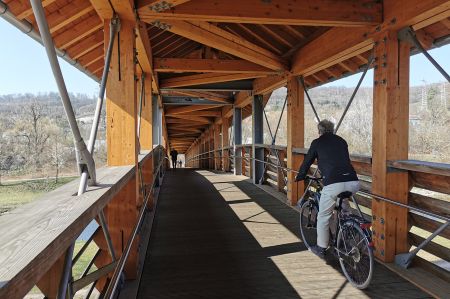Passing Grüttpark to Rötteln Castle near Lörrach
- Written by Portal Editor
During our visit to Weil am Rhein we also wanted to explore the town and surroundings of Lörrach, in particular the Rötteln Castle, as part of a day visit.
So we first rode our bikes to a bicycle parking lot at Grüttpark, from where we were supposed to continue on foot. The Grütt Landscape Park is a 51-hectare, popular green and leisure area in Lörrach, where the Baden-Württemberg State Horticultural Show took place in 1983 on the newly designed site. Today, the largest park in Lörrach is considered a local recreation area for the city and its surroundings, which we can only affirm. At the same time, large parts of the park area are a water protection area with several deep wells. Overall, the area covers an area of around one square kilometre. The semi-natural inland waters including their bank vegetation are even legally protected biotopes.
Hiking and biking trails through the Grüttpark
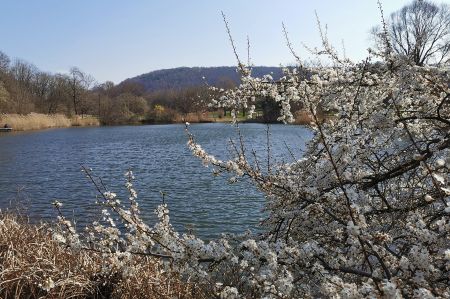 In addition to playgrounds and sports fields and barbecue facilities, the Grüttpark leisure facilities also include a café and walking and cycling paths, as we should discover a little later on our way to Rötteln Castle. Exhibition halls, various leisure facilities, the Grüttpark stadium and other sports facilities are located on the edge of the park area. The park is divided into two sections by the Wiesental bridge, which is part of the A 98, and a cross brace to the main road, which are connected by a footbridge and a pedestrian and bicycle underpass. The park is the location of several works of art in public space.
In addition to playgrounds and sports fields and barbecue facilities, the Grüttpark leisure facilities also include a café and walking and cycling paths, as we should discover a little later on our way to Rötteln Castle. Exhibition halls, various leisure facilities, the Grüttpark stadium and other sports facilities are located on the edge of the park area. The park is divided into two sections by the Wiesental bridge, which is part of the A 98, and a cross brace to the main road, which are connected by a footbridge and a pedestrian and bicycle underpass. The park is the location of several works of art in public space.
In addition to paths for walkers and cyclists, a nature trail with ten stations leads through the complex. A section of the lever hiking trail also runs through the Grüttpark; one station is located on the southern shore of the artificially created Grüttsee. The partly asphalted and partly gravelled path network in the park covers more than ten kilometres, which already shows the size of the Grüttpark.
The park is flat with virtually no natural or artificial hills. At the western end is a 1970 furnished campsite with mobile home parking, tennis and soccer fields. The Grüttpark Stadium, built between 1964 and 1966, is also there. There is another restaurant near the main entrance to the stadium.
Water areas are a focal point in the Grüttpark
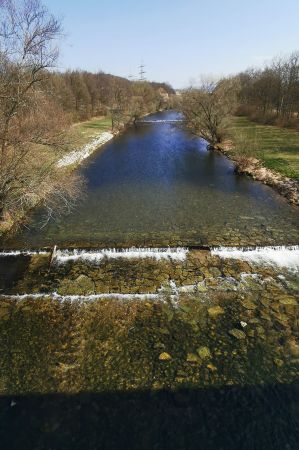 The Grüttbach flows through the park and the Grüttsee. Both bodies of water were created artificially. The Grüttbach springs from an artificial, walk-in spring trough. The creek flows almost through the entire park from northeast to southwest. Smaller footbridges and bridges cross it. There are four shelters designed as pavilions in the park. A Kneipp facility on the stream was installed in 1982/83 as an accompanying measure for the garden show.
The Grüttbach flows through the park and the Grüttsee. Both bodies of water were created artificially. The Grüttbach springs from an artificial, walk-in spring trough. The creek flows almost through the entire park from northeast to southwest. Smaller footbridges and bridges cross it. There are four shelters designed as pavilions in the park. A Kneipp facility on the stream was installed in 1982/83 as an accompanying measure for the garden show.
The water system of the Grütt is fed, among other things, by the Heilisau springs. The springs at an altitude of around 340 meters are around 50 meters higher than the park and are fed into the park to the north and discharged to the south by the underground streams. The Grüttbach, which flows from north to south and is about 2 kilometres long, emerges from an artificial spring near the exhibition halls.
In the middle of the park is the Grüttsee, which is around 12,000 square meters in size and only a few meters deep. Its lake level is 294 m above sea level. NN height created. Originally, a second, approximately 3,100 square meter lake ("model boat lake") was planned for the state horticultural show, so as not to disturb the Grüttsee with leisure activities. For ecological reasons, this second flat lake was not included in the planning later. According to the environmental protection regulations, bathing, boating, surfing, fishing, the use of model boats as well as ice skating and stepping on ice surfaces are prohibited in Grüttsee.
Rosarium in Grüttpark
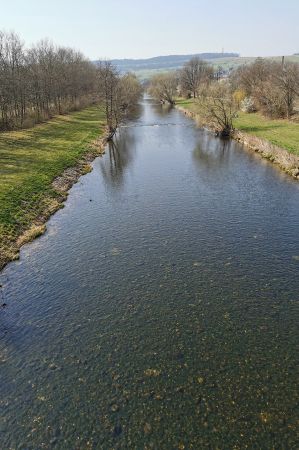 South of the Grüttsee lies the approximately 1-hectare large rose garden on the edge of a low terrace, the location of which was determined by the municipal protection ordinance. The rosarium contains about 2,500 rose bushes of 170 species and varieties, resulting in various formations. Around 7,500 roses from 30 species were planted on the slope facing the lake. Different climbing aids and scaffolding are used for the different classes of roses. The main course under a rose arch leads to Café Rosengarten. In the centre of the rose garden is a fountain by the Freiburg artist Bollin. Ten spherical acacia trees line the square. From there, paths lead in a star shape to the semi-circular beds. The beds, which have a variety of colours and shapes in summer, are separated by green lawns. The rose garden is bordered in the direction of residential development with yews, oaks, hornbeams and Japanese cherry trees.
South of the Grüttsee lies the approximately 1-hectare large rose garden on the edge of a low terrace, the location of which was determined by the municipal protection ordinance. The rosarium contains about 2,500 rose bushes of 170 species and varieties, resulting in various formations. Around 7,500 roses from 30 species were planted on the slope facing the lake. Different climbing aids and scaffolding are used for the different classes of roses. The main course under a rose arch leads to Café Rosengarten. In the centre of the rose garden is a fountain by the Freiburg artist Bollin. Ten spherical acacia trees line the square. From there, paths lead in a star shape to the semi-circular beds. The beds, which have a variety of colours and shapes in summer, are separated by green lawns. The rose garden is bordered in the direction of residential development with yews, oaks, hornbeams and Japanese cherry trees.
Bitter orange trees, gingko trees and sequoias in the park
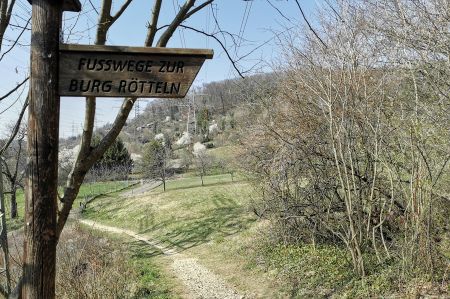 The Grütt Landscape Park, which naturally still belongs to the Markgräfler Hügelland or to the foothills of the Dinkelberg, is characterized by spacious meadow areas. Lawn and planted areas make up more than 80% of the total parking area. In particular, around the Grüttsee and at the source of the Grüttbach, plants surround the waters. At the Grüttsee, the water surface merges into the land surface through reed beds. Native and exotic trees and shrubs form the plant diversity of the facility. There are several sequoias (including giant sequoia, primeval sequoia) along the path in the direction of the water works. There are currently around 60,000 trees and shrubs from around 60 species in the Grüttpark - at the State Horticultural Show there were around 25,000. In addition to the native poplars and alders, there are bitter orange trees, bald cypresses, medlars, snakeskin maples and ginkgo trees in Grütt.
The Grütt Landscape Park, which naturally still belongs to the Markgräfler Hügelland or to the foothills of the Dinkelberg, is characterized by spacious meadow areas. Lawn and planted areas make up more than 80% of the total parking area. In particular, around the Grüttsee and at the source of the Grüttbach, plants surround the waters. At the Grüttsee, the water surface merges into the land surface through reed beds. Native and exotic trees and shrubs form the plant diversity of the facility. There are several sequoias (including giant sequoia, primeval sequoia) along the path in the direction of the water works. There are currently around 60,000 trees and shrubs from around 60 species in the Grüttpark - at the State Horticultural Show there were around 25,000. In addition to the native poplars and alders, there are bitter orange trees, bald cypresses, medlars, snakeskin maples and ginkgo trees in Grütt.
We had stayed almost too long in the Grüttopark, where our actual destination was still a long way off: the Rötteln Castle. But more on that later.
Please read as well:
The Ottoman Bedesten of Thessalonica
Tasty Mulberries or Karadut from Alanya
-
 Hiking the Grüttpark next to Lörrach
Hiking the Grüttpark next to Lörrach
Hiking the Grüttpark next to Lörrach
Hiking the Grüttpark next to Lörrach
-
 Hiking the Grüttpark next to Lörrach
Hiking the Grüttpark next to Lörrach
Hiking the Grüttpark next to Lörrach
Hiking the Grüttpark next to Lörrach
-
 Hiking the Grüttpark next to Lörrach
Hiking the Grüttpark next to Lörrach
Hiking the Grüttpark next to Lörrach
Hiking the Grüttpark next to Lörrach
-
 Hiking the Grüttpark next to Lörrach
Hiking the Grüttpark next to Lörrach
Hiking the Grüttpark next to Lörrach
Hiking the Grüttpark next to Lörrach
-
 Hiking the Grüttpark next to Lörrach
Hiking the Grüttpark next to Lörrach
Hiking the Grüttpark next to Lörrach
Hiking the Grüttpark next to Lörrach
-
 Hiking the Grüttpark next to Lörrach
Hiking the Grüttpark next to Lörrach
Hiking the Grüttpark next to Lörrach
Hiking the Grüttpark next to Lörrach
https://www.alaturka.info/en/germany/baden-wuerttemberg/5620-passing-gruettpark-to-roetteln-castle-near-loerrach#sigProId57088bcbe1
